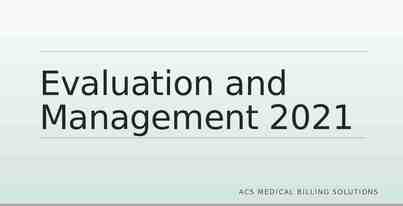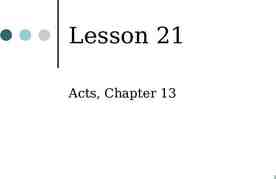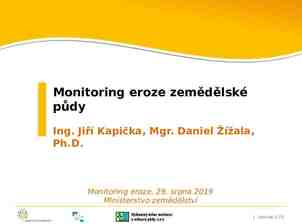Classical Organizational Theory Vincent Myers And Nina Presuto
28 Slides122.50 KB
Classical Organizational Theory Vincent Myers And Nina Presuto
Main idea of classical organizational theory There is “one best way” to perform a task
Classical organizational theory espouses two perspectives: Scientific management – focusing on the management of work and workers Administrative management - addressing issues concerning how overall organization should be structured
Major contributors to the Classical Organizational Theory: Scientific Management: Frederick Taylor Administrative Management: Henri Fayol Luther Halsey Gulick Max Weber
Frederick Taylor Taylor is born in Pennsylvania on March 20, 1856 After studying in Europe, he plans to go to Harvard, but does not pass the entrance exams Instead Taylor works as a pattern maker at a pump manufacturing company in Philadelphia Later, he studies mechanical engineering at Stevens, finishing in just three years.
Taylor identifies two people as having influenced him: Lucian Sharpe impresses Taylor with his focus, concentration, and task commitment John Griffith teaches Taylor how to be an appreciative, respectful, and admirable working mechanic
Midvale Steel Company Taylor begins working for the Midvale steel Company in 1878. While there he succeeds in doubling the work of his men, is soon promoted to foreman As foreman, he begins studying productivity as a means of measuring of manufacturing. Later he becomes the chief engineer at Midvale.
Ingenuity and Accomplishments Creates systems to gain maximum efficiency from workers and machines in the factory. Focuses on time and motion studies to learn how to complete a task in the least amount of time. Becomes consulting engineer for many other companies Publishes—The Principles of Scientific Management
Key Points of Scientific Management 1. Scientific Job Analysis – observation, data gathering, and careful measurement determine “the one best way” to perform each job 2. Selection of Personnel – scientifically select and then train, teach, and develop workers 3. Management Cooperation – managers should cooperate with workers to ensure that all work is done in accordance with the principles of the science that developed the plan 4. Functional Supervising – managers assume planning, organizing, and decision-making activities, and workers perform jobs
Henri Fayol Engineer and French industrialist In France works as a managing director in coalmining organization Recognizes to the management principles rather than personal traits While others shared this belief, Fayol was the first to identify management as a continuous process of evaluation.
Fayol’s 5 Management Functions Fundamental roles performed by all managers: Planning Organizing Commanding Coordinating Controlling Additionally Fayol recognizes fourteen principles that should guide the management of organizations.
Fayol’s 14 Principles: 1. Division of Work —improves efficiency through a reduction of waste, increased output, and simplification of job training 2. Authority and Responsibility—authority: the right to give orders and the power to extract obedience – responsibility: the obligation to carry out assigned duties 3. Discipline—respect for the rules that govern the organization
4. Unity of Command—an employee should receive orders from one superior only 5. Unity of Direction—grouping of similar activities that are directed to a single goal under one manager 6. Subordination of Individual Interests to the General Interest—interests of individuals and groups should not take precedence over the interests of the organization as a whole. 7. Remuneration of Personnel—payment should be fair and satisfactory for employees and the organization 8. Centralization—managers retain final responsibility – subordinates maintain enough responsibility to accomplish their tasks
9. Scalar Chain (Line of Authority)—the chain of command from the ultimate authority to the lowest 10. Order—people and supplies should be in the right place at the right time 11. Equity—managers should treat employees fairly and equally 12. Stability of Tenure of Personnel—managerial practices that encourage long-term commitment from employees create a stable workforce and therefore a successful organization 13. Initiative—employees should be encouraged to develop and carry out improvement plans 14. Esprit de Corps—managers should foster and maintain teamwork, team spirit, and a sense of unity among employees
Luther Halsey Gulick (1892-1992) A specialist in municipal finance and administration Gulick works with the Institute of Public Administration, professor of municipal science and administration at Columbia, and serves on Franklin D. Roosevelt’s Committee of Government Administration Expands Fayol’s five management functions into seven functions:
1. Planning - developing an outline of the things that must be accomplished and the methods for accomplishing them 2. Organizing - establishes the formal structure of authority through which work subdivisions are arranged, defined, and coordinated to implement the plan 3. Staffing - selecting, training, and developing the staff and maintaining favorable working conditions 4. Directing - the continuous task of making decisions, communicating and implementing decisions, and evaluating subordinates properly
5. Coordinating - all activities and efforts needed to bind together the organization in order to achieve a common goal 6. Reporting - verifies progress through records, research, and inspection; ensures that things happen according to plan; takes any corrective action when necessary; and keeps those to whom the chief executive is responsible informed 7. Budgeting - all activities that accompany budgeting, including fiscal planning, accounting, and control
Max Weber (1864-1920) German sociologist Weber first describes the concept of bureaucracy – an ideal form of organizational structure He defines bureaucratic administration as the exercise of control on the basis of knowledge Weber states, “Power is principally exemplified within organizations by the process of control”
Weber uses and defines the terms authority and power as: Power: any relationship within which one person could impose his will, regardless of any resistance from the other. Authority: existed when there was a belief in the legitimacy of that power.
Weber classifies organizations according to the legitimacy of their power and uses three basic classifications: Charismatic Authority: based on the sacred or outstanding characteristic of the individual. Traditional Authority: essentially a respect for customs. Rational Legal Authority: based on a code or set of rules.
Weber recognizes that rational legal authority is used in the most efficient form of organization because: A legal code can be established which can claim obedience from members of the organization The law is a system of abstract rules which are applied to particular cases; and administration looks after the interests of the organization within the limits of that law.
The manager or the authority additionally follows the impersonal order Membership is key to law obedience Obedience is derived not from the person administering the law, but rather to the impersonal order that installed the person’s authority
Weber outlined his ideal bureaucracy as defined by the following parameters: A continuous system of authorized jobs maintained by regulations Specialization: encompasses a defined “sphere of competence,” based on its divisions of labor A stated chain of command of offices: a consistent organization of supervision based on distinctive levels of authority
Rules: an all encompassing system of directives which govern behavior: rules may require training to comprehend and manage Impersonality: no partiality, either for or against, clients, workers, or administrators Free selection of appointed officials: equal opportunity based on education and professional qualification
Full-time paid officials: only or major employment; paid on the basis of position Career officials: promotion based on seniority and merit; designated by supervisors Private/Public split: separates business and private life The finances and interests of the two should be kept firmly apart: the resources of the organization are quite distinct from those of the members as private individuals.
(a) A tendency to a leveling of social classes by allowing a wide range of recruits with technical competence to be taken by any organization (b) Elite status because of the time required to achieve the necessary technical training (c) Greater degree of social equality due to the dominance of the spirit of impersonality or objectivity
Common Criticisms of Classical Organizational Theory Classical principles of formal organization may lead to a work environment in which: Employees have minimal power over their jobs and working conditions Subordination, passivity and dependence are expected work to a short term perspective Employees are lead to mediocrity Working conditions produce to psychological failure as a result of the belief that they are lower class employees performing menial tasks
Activity: Break into four groups: Taylor, Fayol, Gulick and Weber Refer to the power point notes you have been given to examine a classical organizational theorist’s principles Consider what you discussed about each principle Analyze how the theorists beliefs exist, don’t exist, or are modified within today’s educational world Please have someone take notes on your work Lead a discussion of how your theorist’s ideas relate to the current system of educational administration

































